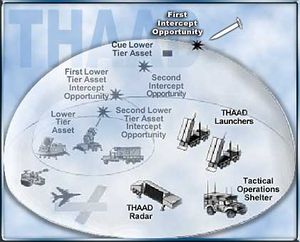Terminal High Altitude Area Defense (missile)
Terminal High Altitude Area Defense (THAAD) (originally named Theater High Altitude Air Defense) is a U.S. Army system for area-wide defense against theater ballistic missiles. It is intended to form the upper tier of a layered defense system, in which the MIM-104 Patriot PAC-3 missile system is the "lower tier asset" in the graphic at left.
THAAD is a "hit-to-kill" missile interceptor, in contrast to Patriot, which uses a blast-fragmentation proximity warhead.Blast-fragmentation becomes far less effective in the absence of atmosphere, and THAAD has been described as being able to engage targets at an altitude of 150km, definitely exoatmospheric. [1]
Radar, Command & Control, and linkage to other systems
The main THAAD ground radar is the AN/TPY-2, which is already operational in various surveillance roles, and is reported to work well. Its range is classified, but considerably greater than the THAAD missile range of 200 km.
THAAD firing units tie into a wide range of communications systems, including the Joint Tactical Information Distribution System, the obsolescent Mobile Subscriber Equipment, SINCGARS radios (to be replaced by the Joint Tactical Radio System. These are tactical systems. The AN/TPY-2 radar, like the Navy's AN/SPY-2 radar on ships with the ballistic missile defense enhancements to the AEGIS battle management system, can cooperate in acquiring targets for national ballistic missile defense. THAAD will also have access to national-level intelligence assets,
THAAD missile
While the radar, and linkage to other systems, the missile performance has had a checkered test record. Understandably, making contact with a 370mm-diameter kill vehicle takes precise guidance. Early tests, through 2002, had flight failures, [2], but there has been more success from 2006 on.[3]
Physically, it consists of a single-stage solid rocket booster, from which the kill vehicle (KV) is detached by a separation motor. Once the KV separates, it maneuvers using a liquid-fueled divert and attitude control system, and a infrared seeker mounted on a gimbal mount.
References
- ↑ "THAAD Theatre High-Altitude Area Defence Missile System, USA", Army Technology
- ↑ Center for Defense Information, Missile Defense Flight Tests: Theater High-Altitude Area Defense System flight test history
- ↑ Missile Defense Agency, U.S. Department of Defense

